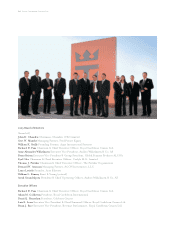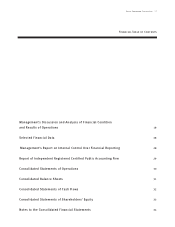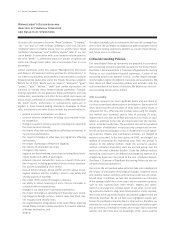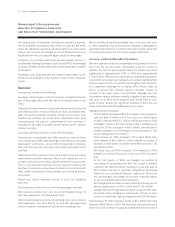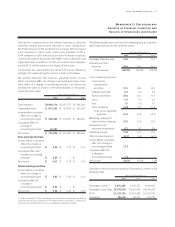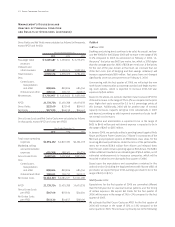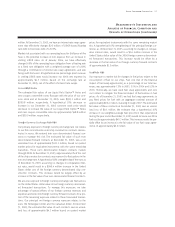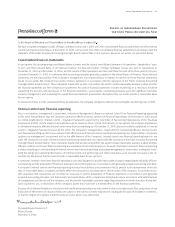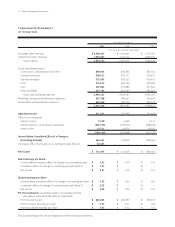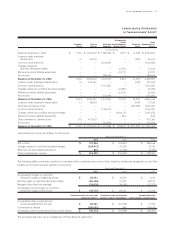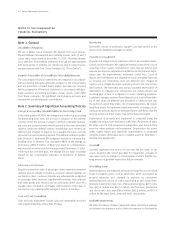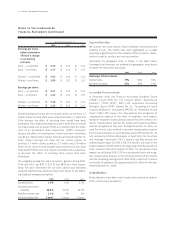Royal Caribbean Cruise Lines 2005 Annual Report Download - page 28
Download and view the complete annual report
Please find page 28 of the 2005 Royal Caribbean Cruise Lines annual report below. You can navigate through the pages in the report by either clicking on the pages listed below, or by using the keyword search tool below to find specific information within the annual report.
Some of the contracts that we enter into include indemnification
provisions that obligate us to make payments to the counterparty if
certain events occur. These contingencies generally relate to
changes in taxes, increased lender capital costs and other similar
costs. The indemnification clauses are often standard contractual
terms and are entered into in the normal course of business. There
are no stated or notional amounts included in the indemnification
clauses and we are not able to estimate the maximum potential
amount of future payments, if any, under these indemnification
clauses. We have not been required to make any payments under
such indemnification clauses in the past and, under current circum-
stances, we do not believe an indemnification in any material
amount is probable.
As a normal part of our business, depending on market conditions,
pricing and our overall growth strategy, we continuously consider
opportunities to enter into contracts for the building of additional
ships. We may also consider the sale of ships. We continuously con-
sider potential acquisitions and strategic alliances. If any of these
were to occur, they would be financed through the incurrence of
additional indebtedness, the issuance of additional shares of equity
securities or through cash flows from operations.
Funding Sources
As of December 31, 2005, our liquidity was $1.0 billion consisting of
approximately $0.1 billion in cash and cash equivalents and $0.9
billion available under our unsecured revolving credit facility. (See
Note 5.
Long-Term Debt
to our consolidated financial statements.)
We have commitments of approximately $1.5 billion due during the
twelve-month period ending December 31, 2006. These commit-
ments will be funded through a combination of cash flows from
operations, drawdowns under our available unsecured revolving
credit facility, the incurrence of additional indebtedness and the
sales of equity or debt securities in private or public securities mar-
kets. Although we believe our existing unsecured revolving credit
facility, cash flows from operations, our ability to obtain new borrow-
ings and/or raise new capital or a combination of these sources will
be sufficient to fund operations, debt payment requirements, capital
expenditures and other commitments over the next twelve-month
period, there can be no assurances that these sources of cash will be
available in accordance with our expectations.
Our financing agreements contain covenants that require us, among
other things, to maintain minimum net worth, and fixed charge cov-
erage ratio and limit our debt to capital ratio. We were in compliance
with all covenants as of December 31, 2005.
If any person other than A. Wilhelmsen AS. and Cruise Associates,
our two principal shareholders, acquires ownership of more than 30%
of our common stock and our two principal shareholders, in the aggre-
gate, own less of our common stock than such person and do not col-
lectively have the right to elect, or to designate for election, at least
a majority of the board of directors, we may be obligated to prepay
indebtedness outstanding under the majority of our credit facilities,
which we may be unable to replace on similar terms. If this were to
occur, it could have an adverse impact on our liquidity and operations.
Quantitative and Qualitative Disclosures
About Market Risk
We are exposed to market risk attributable to changes in interest rates,
foreign currency exchange rates and fuel prices. We minimize these
risks through a combination of our normal operating and financing
activities and through the use of derivative financial instruments pur-
suant to our hedging practices and policies. The financial impacts of
these hedging instruments are primarily offset by corresponding
changes in the underlying exposures being hedged. We achieve this by
closely matching the amount, term and conditions of the derivative
instrument with the underlying risk being hedged. We do not hold or
issue derivative financial instruments for trading or other specula-
tive purposes. We monitor our derivative positions using techniques
including market valuations and sensitivity analyses. (See Note 10.
Financial Instruments
to our consolidated financial statements.)
Our exposure to market risk for changes in interest rates relates to
our long-term debt obligations and our operating lease for
Brilliance
of the Seas
. At December 31, 2005, 66% of our long-term debt was
effectively fixed and 34% was floating. We enter into interest rate
swap agreements to modify our exposure to interest rate move-
ments and to manage our interest expense and rent expense.
Market risk associated with our long-term fixed rate debt is the
potential increase in fair value resulting from a decrease in interest
rates. At December 31, 2005, our interest rate swap agreements
effectively changed $268.8 million of fixed rate debt with a weight-
ed-average fixed rate of 7.8% to LIBOR-based floating rate debt. The
estimated fair value of our long-term fixed rate debt at December 31,
2005, excluding our Liquid Yield Option™ Notes and zero coupon
convertible notes, was $2.4 billion using quoted market prices,
where available, or using discounted cash flow analyses based on
market rates available to us for similar debt with the same remain-
ing maturities. The fair value of our associated interest rate swap
agreements was estimated to be $10.5 million as of December 31,
2005 based on quoted market prices for similar or identical financial
instruments to those we hold. A hypothetical one percentage point
decrease in interest rates at December 31, 2005 would increase the
fair value of our long-term fixed rate debt, excluding our Liquid Yield
Option™ Notes and zero coupon convertible notes, by approximately
$110.7 million, net of an increase in the fair value of the associated
interest rate swap agreements.
Market risk associated with our long-term floating rate debt is the
potential increase in interest expense from an increase in interest
rates. A hypothetical one percentage point increase in interest rates
would increase our 2006 interest expense by approximately $7.6
26 Royal Caribbean Cruises Ltd.
Management’s Discussion and
Analysis of Financial Condition
and Results of Operations (continued)


